My Korean eggplant recipe is steamed until tender, then tossed in a pungent, sweet and slightly smoky garlic sauce. The first velvety bite reminds me of sitting in my favorite late night K-Town restaurant with friends, at a table packed with colorful banchan. I made sure this Korean garlic eggplant recipe could be ready in about 20 minutes, start to finish.
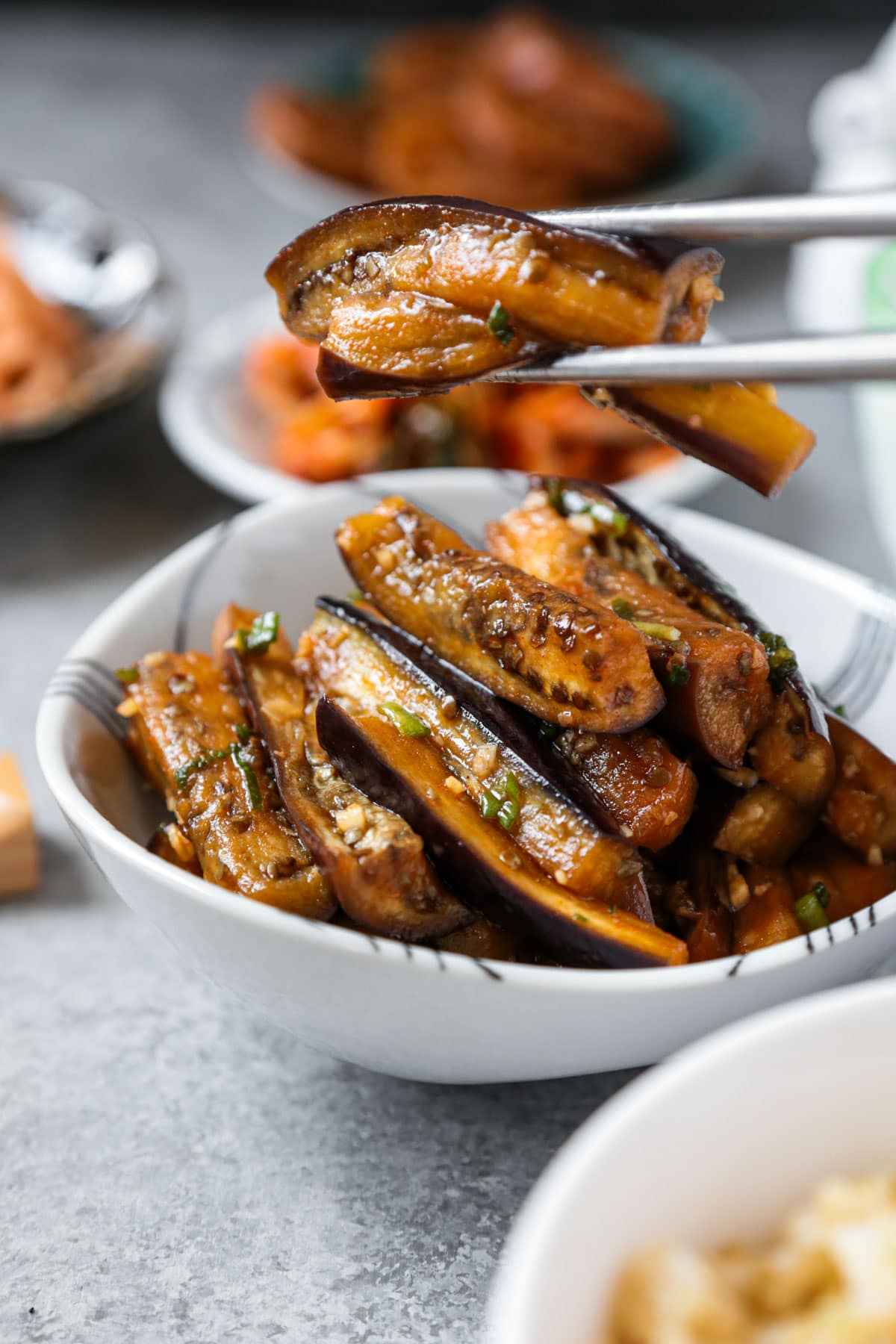
I crave Korean food at inopportune times. Like at midnight, wrapped in a cozy blanket on the couch. It’s just how I’m wired. Steamed Korean eggplant, marinated in soy sauce, fish sauce and sesame oil – garnished with minced garlic and green onions is always worth getting off the couch to make. It’s called gaji namul – and it’s an iconic Korean banchan (side dish) that is typically served either cold or at room temperature. When I cook the eggplant, I’m honing in on a texture that is tender and creamy (but it shouldn’t be falling apart). 20 minutes later, chopsticks in hand, I’m always glad I made the effort.
Table of Contents
Why This Recipe Works
- Korean eggplant has a velvety texture, thin skin and cooks quicker than globe eggplant.
- A low-cal recipe, but punchy and assertive authentic Korean flavors.
- It’s versatile. I serve it as an appetizer (banchan) – or as a light main with rice.

Ingredients
Scroll to the bottom of this page for the full recipe steps and measurements!
- Eggplant: I use about 1-pound of eggplant. If you’re using long, slender Asian eggplant, that’s usually about 3-4 total.
- Green Onions and Garlic: Minced garlic and chopped green onions do a lot for both sharp, pungent flavor – as well as texture.
- Soy Sauce: For big time umami.
- Sesame Oil: I use toasted sesame oil specifically.
- Fish Sauce: Fish sauce is briny, salty – and introduces so much depth of flavor to this Korean eggplant recipe. It’s available at most grocery stores these days, or you can grab fish sauce online.
- Honey: A tablespoon of honey imparts a mild sweetness that compliments the otherwise savory marinade.
- Rice Vinegar: Rice vinegar is bright but mellow. Not too sharp.
- Gochujang: This is a funky, spicy and sweet Korean red chili paste made from fermented soybeans and red chili powder. It’s magnificent.
- Salt: Just a pinch or two, to taste.
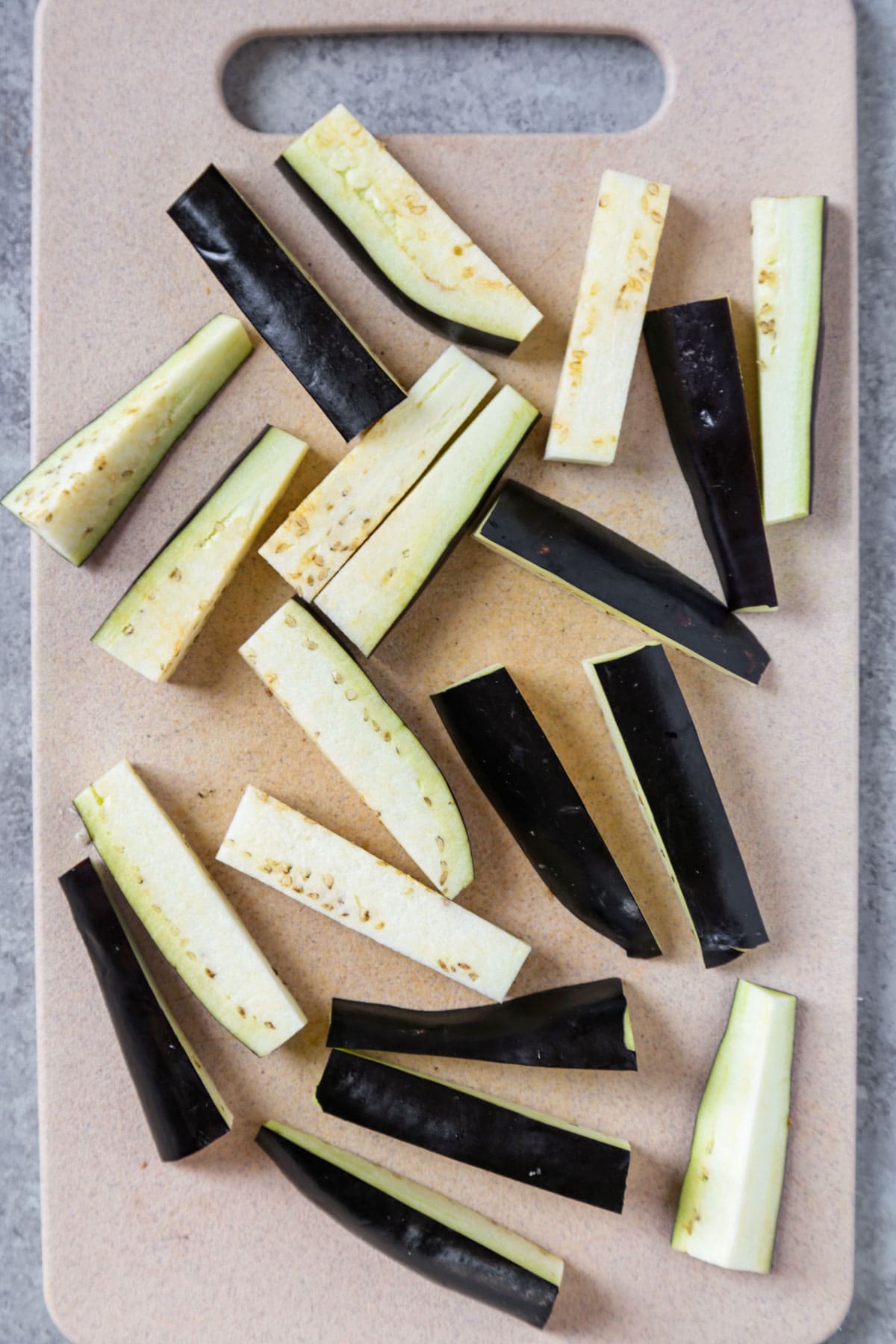
The Best Eggplant to Use For This Recipe
- Look for eggplant at the grocery store called Chinese or Japanese eggplant. Depending on the market, they might also be labeled Korean eggplant.
All three varieties are long and slender with reasonably thin, shiny skins. These eggplant cook quickly and have fewer seeds. They’re what I use when making stir fried eggplant with garlic sauce as well.
Globe eggplant (the thick, round ones) take longer to cook, are packed with seeds and have thicker skins. They work in a pinch, but aren’t ideal.
Equipment
I’m using a steamer basket to steam the eggplant. However, if you don’t have a steamer basket handy, you can use a colander or metal strainer instead.
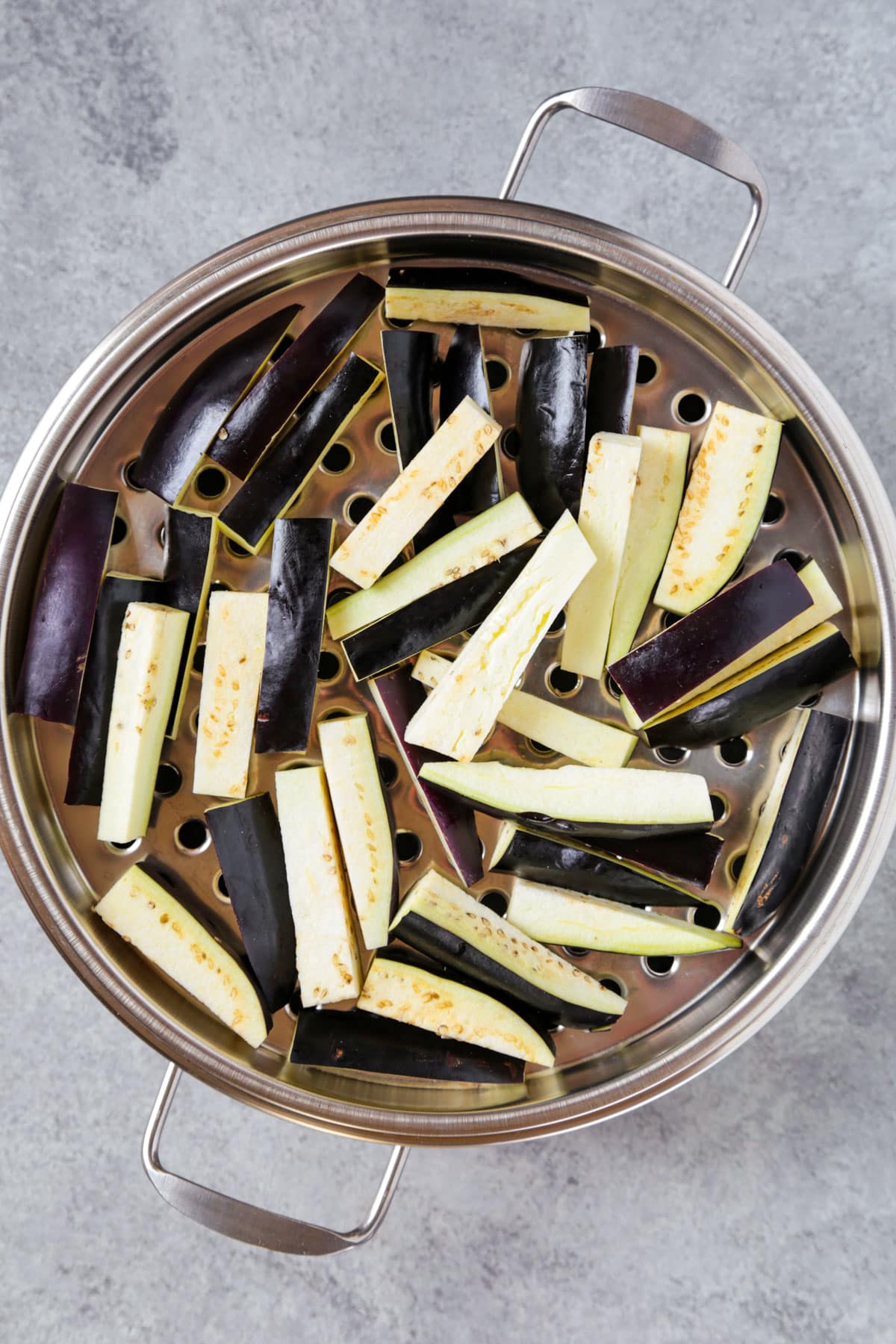

How to Make Steamed Korean Eggplant
- Prepare the eggplant. Trim the stems off your whole eggplant, then slice into pieces that are roughly 3 inches long and an inch thick. Place the eggplant pieces into a steamer basket.
- Steam the eggplant. Add about 2 cups of water to a pot and bring to a boil on the stovetop. Once boiling, place the steamer basket atop the pot and cover with a lid (or foil). Lower the heat to medium and steam the eggplant pieces until tender – but not falling apart. This should take 8-12 minutes. Test often. Once the eggplant is tender, turn the heat off and transfer the eggplant pieces to a bowl or plate and allow to cool a bit.
- Make the garlic sauce. In a separate mixing bowl, combine the garlic, green onions, soy sauce, sesame oil, honey, gochujang, fish sauce and rice vinegar and mix well.
- Mix and serve. Once the eggplant has cooled down, add it to the mixing bowl and toss until well mixed. Season with salt if needed and serve.
Expert Tip You can test the doneness of your eggplant while it is still in the steamer basket. Poke a piece with a chopstick or the tines of a fork. If you can pierce the outer skin and the inner flesh easily, it’s good to go. If not, keep steaming.
Recipe Variations
- Make it spicy. When I’m craving a little more heat, I add a teaspoon or two of gochugaru (Korean red chili pepper powder). It’s mildly spicy – but also fairly smoky – and compliments the gochujang really nicely.
- Make it mild. If you have a sensitive palate, just omit the gochujang entirely. I did this when I made it for my mother in law (even black pepper makes her sneeze), and she loved it.
- Go lower sodium. Watching your salt intake? Omit the fish sauce.
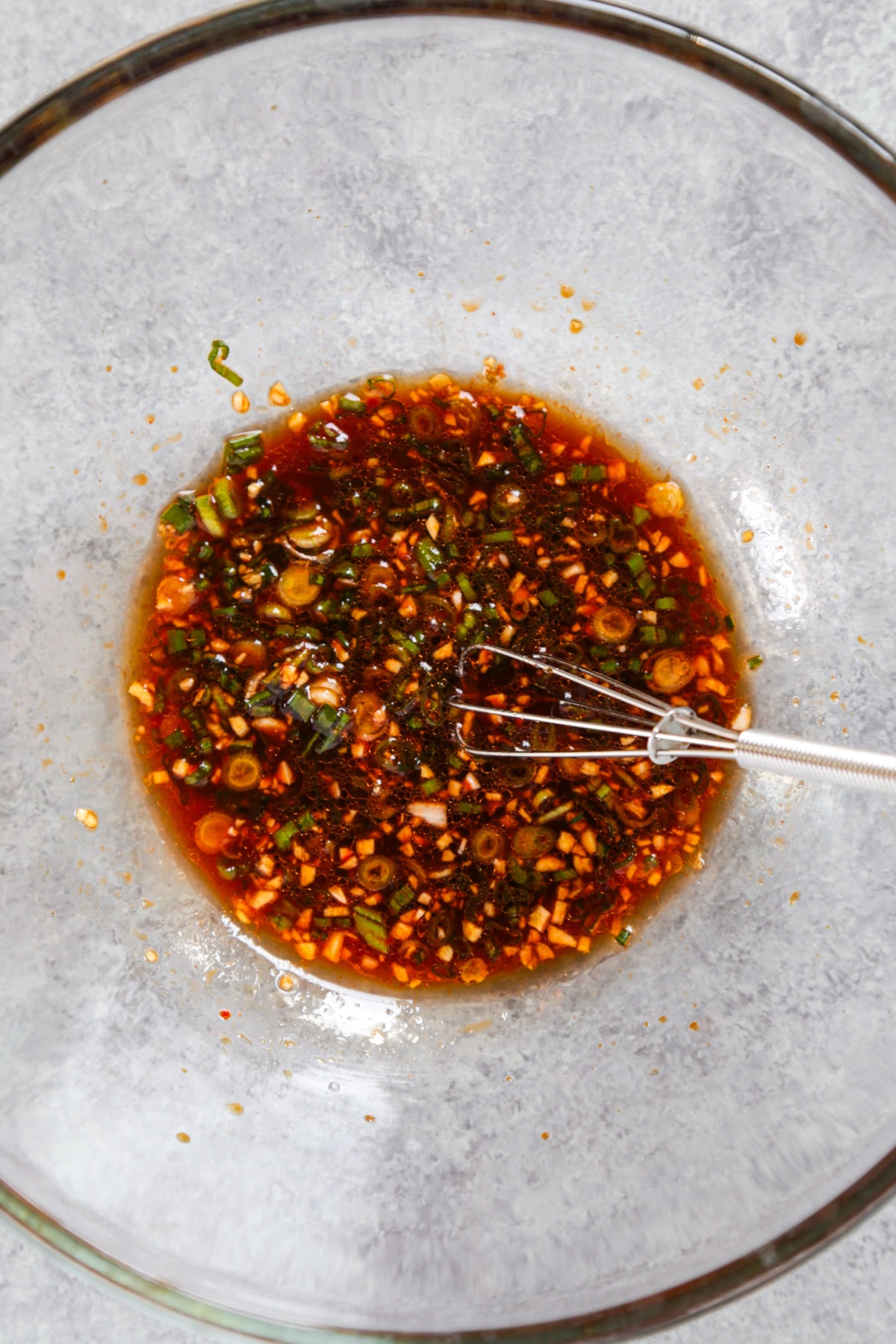

Storage
Cover and refrigerate any leftovers for up to 5 days.
Eat leftovers cold, right out of the fridge. The flavors should actually deepen during storage. However, you can add a tiny splash of soy sauce and sesame oil if you need an additional seasoning boost.
Frequently Asked Questions
It can be! But you’ll have to make a couple ingredient changes. For a vegan gaji namul, the fish sauce will have to go. Instead of fish sauce, just use an equal amount of soy sauce. So, for this recipe, you’d be using 1 1/2 tablespoons of soy sauce total. The second ingredient you’ll 86 is the honey. Simply swap the honey out for agave nectar instead.
Since it has soy sauce, this recipe is not gluten free as written. However, you can easily use liquid aminos or tamari instead of the soy sauce. Boom. Easy.
While there’s a little bit of heat from the gochujang, it’s a fairly mild dish overall. This makes it great for people who love punchy Korean flavors, but who may also be sensitive to spicy foods.
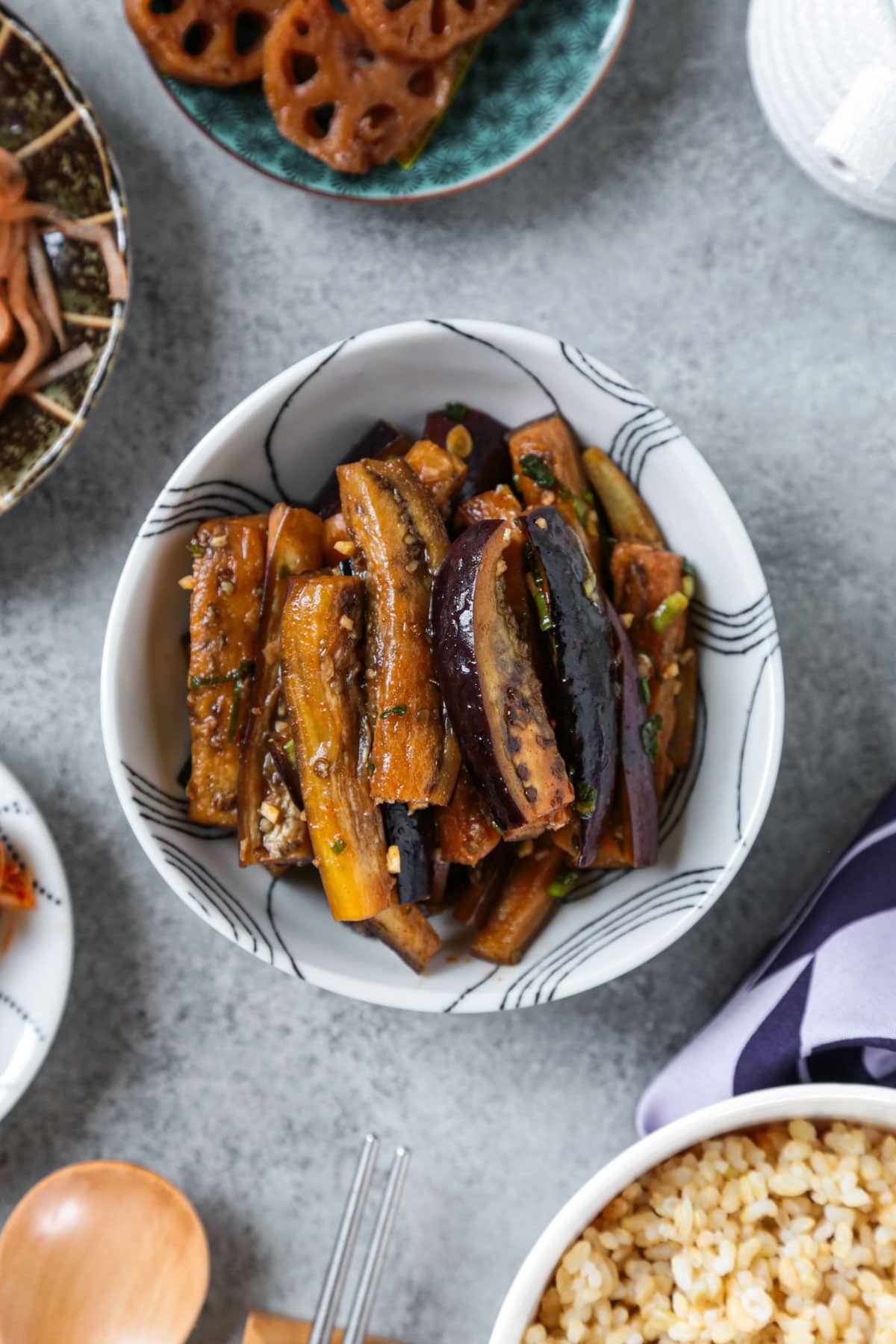
What to Serve With Steamed Korean Eggplant
At a Korean restaurant, banchan are the small plates that arrive at your table after you’ve ordered, but before the main courses arrive. However, they’re not really appetizers. Think of them as snacks you can savor on their own – or as a supporting condiment throughout your entire meal.
I could eat an entire meal of just banchan. Here are a few recipes I frequently serve alongside gaji namul:
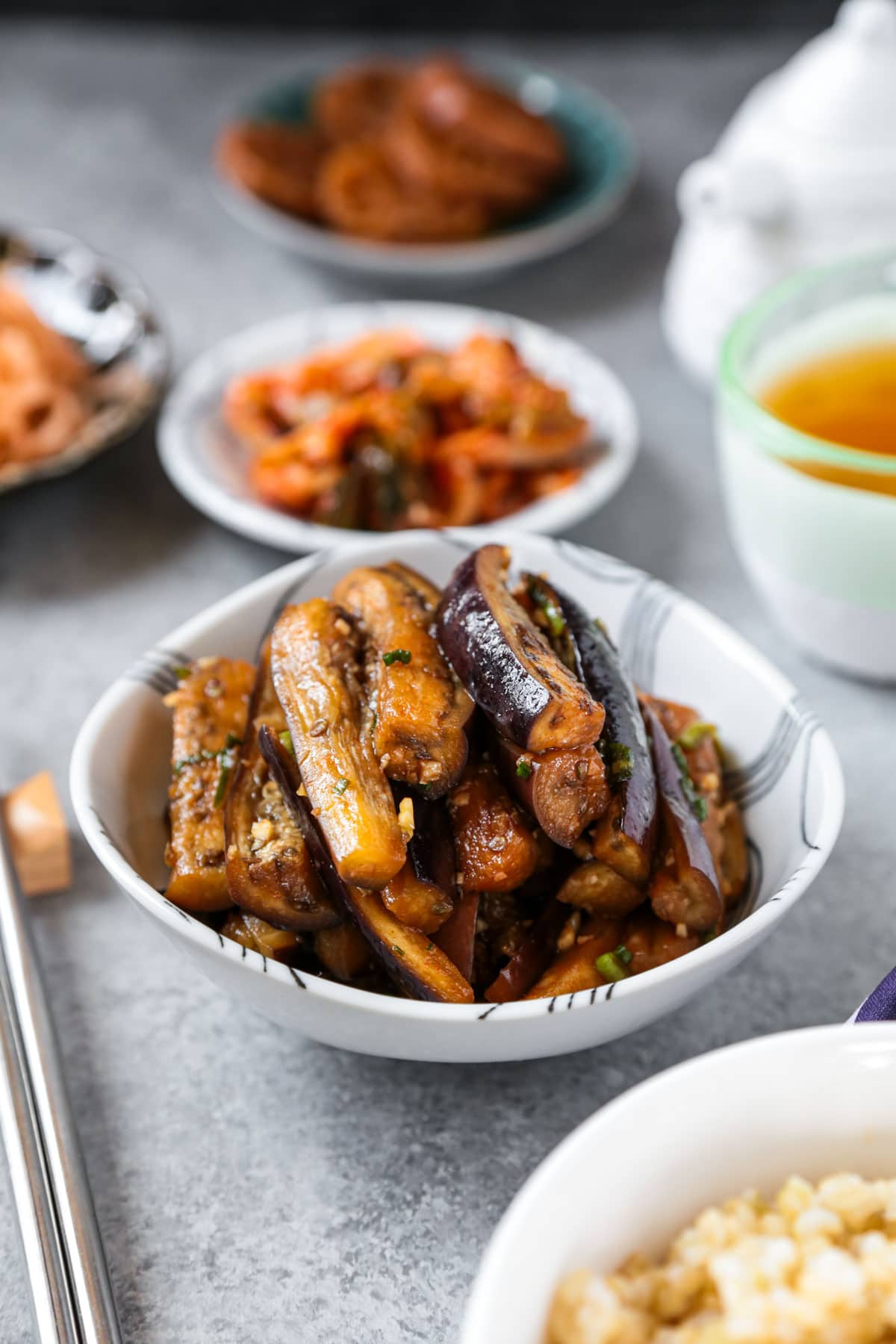
Want to add this eggplant recipe to a full-on Korean banquet? When I go feast-mode, here’s what I make:
- Kimchi Jjigae (Kimchi Stew)
- Vegan Bulgogi
- Pan Fried Tofu With Gochujang Sauce
- Korean Chive Pancake (Buchujeon)
- Rose Tteokbokki (Creamy and Spicy Korean Rice Cakes)
Subscribe to my newsletter and receive the latest recipes and weekly favorites straight to your inbox. Join me on Pinterest, Facebook, and Instagram for more cooking tips and adventures!
Did you like this Korean gaji namul side dish? Are there changes you made that you would like to share? Share your tips and recommendations in the comments section below!
Print
Steamed Korean Eggplant (Gaji Namul)
- Prep Time: 15 minutes
- Cook Time: 7 minutes
- Total Time: 22 minutes
- Yield: 4 sides 1x
- Category: Side
- Method: Steaming
- Cuisine: Korean
- Diet: Low Calorie
Description
Steamed Korean eggplant is garlicky and savory with a hint of spice. Gaji namul will be your new favorite banchan! Ready in 22 minutes from start to finish.
Ingredients
- 1 pound Japanese or Korean eggplant (3 or 4 eggplant)
- 2 green onions, finely chopped
- 2 garlic cloves, minced
- 1 tablespoon soy sauce
- 1 tablespoon toasted sesame oil
- 1/2 tablespoon fish sauce
- 1 tablespoon honey
- 1 tablespoon rice vinegar
- 1 teaspoon gochujang
- Pinch of salt
Instructions
- Trim the eggplant. Cut the ends off the eggplant and slice them into pieces that are 3 inches long and 1 inch thick.
- Steam the eggplant. Place the eggplant pieces in a steamer basket. Add about 1 to 2 cups of water to a pot and bring the water to a boil. Place the steamer basket on top of the pot and cover with a lid or baking foil. Lower the heat to medium and steam the eggplant pieces until they are tender but not falling apart- about 8 to 12 minutes.
- Cool the steamed eggplant. Turn the heat off and transfer the eggplant pieces to a bowl. Let them cool to room temperature.
- Make the sauce. Mix the remaining ingredients in a bowl and, when the eggplant has cooled, add it to the mixing bowl.
- Mix and serve. Gently toss the eggplant pieces until they are evenly coated. Serve.
Notes
Store leftovers in the refrigerator (covered) for up to 5 days.
Nutrition
- Serving Size: 1 serving
- Calories: 82
- Sugar: 8.9g
- Sodium: 312mg
- Fat: 3.7g
- Saturated Fat: 0.5g
- Unsaturated Fat: 1.5g
- Trans Fat: 0g
- Carbohydrates: 12.5g
- Fiber: 3.5g
- Protein: 1.7g
- Cholesterol: 0mg



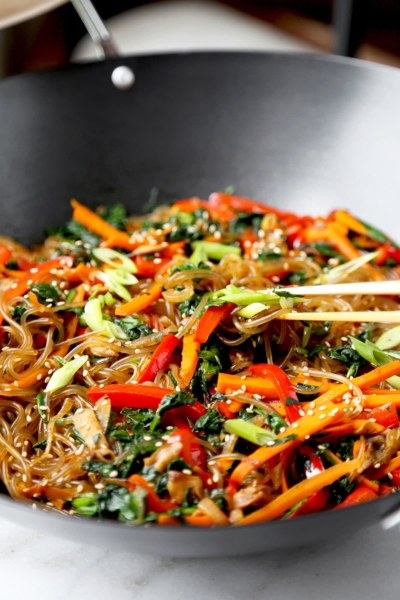














Questions and Reviews
This eggplant is SO delicious! Tender and perfectly flavored. Couldn’t be easier! So much better than sautéing
Fantastic flavour and so easy. I just love the silky feeling of steamed eggplant. Will certainly make this sauce again. Thanks for all the detailed instructions and tips!
Thank you so much! 🙂